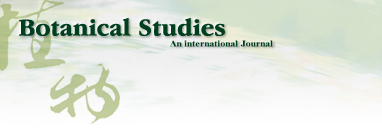 |
|
|
| TITLE | Genome organization and relationships of Phalaenopsis orchids inferred from genomic in situ hybridization |
| AUTHOR | Chih-Chung LIN Department of Botany, National Taiwan University, Taipei 106, Taiwan, ROC Yao-Huang CHEN Department of Horticulture, Taiwan Sugar Research Institute, Tainan 701, Taiwan, ROC Wen-Huei CHEN Department of Horticulture, Taiwan Sugar Research Institute, Tainan 701, Taiwan, ROC Chi-Chang CHEN Department of Botany, National Taiwan University, Taipei 106, Taiwan, ROC Yen-Yu KAO Department of Botany, National Taiwan University, Taipei 106, Taiwan, ROC |
| FULL TEXT | [in HTML format] [in PDF format] |
| ABSTRACT | All Phalaenopsis species have the same chromosome number (2n = 2x = 38), but the sizes of their genomes vary markedly. In this study, we investigated genome organization and relationships of Phalaenopsis species by genomic in situ hybridization (GISH) of seven interspecific hybrids derived from crosses between species with similar or dissimilar sizes of genomes. In the hybrid P. aphrodite × P. sanderiana, in which both parents possess small genomes, the two parental chromosome sets could not be distinguished by the strength and distribution of hybridization signals. Similar results were obtained from the hybrid P. mannii × P. violacea, in which both parents have large genomes. These results suggest that the two parents of these hybrids have similar genomes. In hybrids in which one parent possesses a large and the other parent a small genome, such as P. amboinensis × P. stuartiana, the two parental chromosome sets could readily be distinguished by GISH with or without the application of blocking DNA. Examination of hybridization signals on chromosomes revealed that species with large genomes have much more repetitive sequences, both in type and amount; however, species with small genomes do have their own specific sequences. In general, genome relationships obtained from GISH are in agreement with those from traditional genome analysis of other investigators. This study demonstrates that GISH is a useful tool for investigating genome organization and relationships of plant species, especially when analysis of meiotic behavior is technically difficult. |
| KEYWORD | Genomic in situ hybridization; Genome organization; Genome relationship; Phalaenopsis; |
| ARTICLE INFO | Botanical Bulletin of Academia Sinica, Volume 46 Number 4 October 2005, page 339-345, 7 pages |
| PUBLISHER | Institute of Plant and Microbial Biology, Academia Sinica, Taipei, Taiwan, Republic of China |
